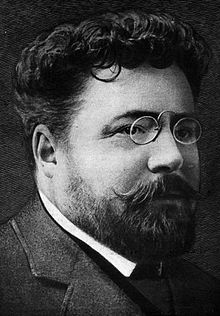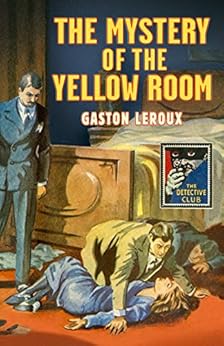Dire du Mystère de la Chambre jaune que c'est un livre sous-estimé peut paraître ridicule. Il fut en effet salué comme un classique dès sa parution, fut filmé plusieurs fois et fit le tour du monde, sa gloire culminant avec une troisième place au classement des meilleurs mystères de chambre close jamais écrits dressé par un aréopage de critiques anglo-saxons. Comment un livre au succès aussi foudroyant peut-il être sous-estimé? Cela défie le sens commun. Et pourtant...
.JPG/250px-Le_Myst%C3%A8re_de_la_chambre_jaune_(couverture).JPG)
Le peu d'intérêt critique chez nous pour le roman d'énigme explique sans doute que peu d'historiens se soient penchés sur le rôle du livre de Leroux dans le développement du genre. Pour beaucoup, il n'est rien de plus qu'un trophée que l'on brandit ponctuellement afin de montrer que, oui, les Français ne sont pas des nains et sont parfaitement capables de rivaliser avec leurs collègues anglo-saxons quand ils le veulent bien. La dimension "accidentelle" du chef-d'oeuvre, sans précédent ni suite dans l'oeuvre de son auteur, est souvent mise en avant. D'autres enfin se montrent gênés, voire réticents devant ce classique si peu... classique fortement ancré dans la littérature populaire de son époque, pour le meilleur comme pour le pire. Peu en tout cas y voient un tournant dans l'histoire de la littérature policière.
Replaçons le livre dans son contexte. Le roman policier français est en 1907 un genre récent, peu codifié et qui n'a même pas de nom universellement accepté. Ses contours sont flous et il n'a pas la rigueur mathématique, ou supposé telle, de son cousin anglais. Il reste largement tributaire de ses origines feuilletonesques et balzaciennes: les détectives - qui n'ont rien de "grand" - sont le plus souvent issus de la police officielle, les intrigues compliquées mais non complexes, l'étude de milieu et de caractère prime et le mélodrame n'est jamais loin. Bref, on n'a pas beaucoup avancé depuis Gaboriau. On sait qu'un autre modèle existe (Collins, Green et Doyle sont traduits de bonne heure) mais l'école française fait - déjà - de la résistance.
 |
| Gaston Leroux |
Le génie de Leroux est de rompre avec les vieux schémas et d'importer le modèle anglo-saxon pour l'adapter au goût français et donc écrire le premier véritable roman d'énigme de notre littérature. Pour la première fois en effet s'opère la synthèse qui sera celle de l'Age d'or du genre deux décennies plus tard. Le Grand Détective (Rouletabille) vient par le seul usage de la raison à bout d'un mystère apparemment insoluble et désigne un coupable parfaitement inattendu, le tout dans une perspective essentiellement ludique et si j'ose dire, "interactive": l'auteur ne cache au rien au lecteur, lui fournit tous les indices et l'invite à résoudre le problème avant le détective.
Le livre n'est certes pas sans défauts, qui n'en étaient d'ailleurs pas à l'époque; le ton emphatique, le comportement parfois peu crédible des personnages et le mobile de l'assassin fleurent bon leur roman-feuilleton. C'est sur ces scories que se focalisent souvent les critiques du livre, surtout dans les pays anglo-saxons habitués à une prose plus mesurée. Un autre problème est que Leroux s'avéra incapable d'exploiter et de systématiser ses découvertes. Le roman suivant, Le Parfum de la Dame en noir, est notoirement beaucoup moins réussi et Leroux se désintéressa ensuite du genre, transformant Rouletabille en aventurier qu'il expédiera aux quatre coins du globe pour des aventures qui n'auront plus rien, ou alors très peu, de policier. La suite, on le connait: c'est un autre auteur au nom de couleur, un certain Maurice Leblanc, qui deviendra la figure tutélaire du roman policier français et l'orientera dans une toute autre direction.
 |
| Un succès international |
Mais par un phénomène assez unique de retour à l'envoyeur, c'est dans les pays anglo-saxons que cette "imitation de l'anglais" allait avoir sa plus longue postérité. Le livre de Leroux est en effet rapidement traduit et obtient un énorme succès outre-Manche et surtout outre-Atlantique. Les futurs ténors du "Golden Age", à commencer par Agatha Christie et - on s'en doutait - John Dickson Carr le lisent et retiennent la leçon. Le triomphe ne s'arrête pas là, car La Chambre jaune se décline bientôt dans pratiquement toutes les langues et devient, et reste encore à ce jour, le roman policier français le plus lu et le plus connu dans le monde - et le seul qui ait changé à jamais la face du genre.
To say that The Mystery of the Yellow Room is underrated can seem rather counter-intuitive. We're talking after all of a book that was almost instantly hailed as a classic, enjoyed many movie adaptations and became a worldwide sensation, even hitting third place in a ranking of the best impossible crime novels compiled eighty years after its first publication. How could such a commercially and critically successful blockbuster ever be underrated? It doesn't make sense - and yet...
 |
| Philippe Ogouz as Rouletabille |
French scholars's lack of interest in the traditional detective novel may explain why so few of them ever cared about the book's role in the shaping and development of the genre. Most regard it as a trophy to be paraded every time the need arises to remind the world that French crime writers can do it just as well as their "Anglo-Saxon" colleagues when they consent to. Some point to the "accidental" nature of the book, as Leroux never wrote anything of the same kind and/or in the same league either before or after it. Still others express discomfort at the book's roots in and debt to French popular fiction of the time, for better and for worse. Very few see it for what it is: a turning point in the history of the genre.
A little context is necessary here. French roman policier is in 1905 a still recent genre with few rules and not even a consensual name. Its features are not fixed and it lacks the alleged mathematical rigour of its English cousin, remaining true to its feuilletonesque and balzacian origins: most of the detectives, rarely "great" in the modern sense, belong to the police force, the plots are more complicated than complex and take a back seat to the study of milieu and character, often with strongly melodramatic overtones; there is no or little attempt made at fooling the reader. In brief not much has changed since Gaboriau's heyday, despite the works of Collins, Green, Doyle being available and pointing to another way of doing crime fiction. Then as always, the French school wanted to do things its own way.
 |
| 1930 movie adaptation |
Leroux's genius lies in breaking up with the tradition and importing the "Anglo-Saxon" model and adapting it to the local taste; in so doing he wrote the first modern French detective novel. For the first time in French fiction and elsewhere for that matter is achieved the synthesis that would be associated with the Golden Age twenty years later: The Great Detective (Rouletabille) uses his brains to solve a mystery that baffled everyone else, and unmasks a totally unexpected guilty party, with the book also working as a game as the author gives the reader all the clues needed to arrive at the solution and challenges them to solve the mystery before the detective. Revolutionary, isn't it?
This is not to say that the book is without flaws - it has a plenty of them, though not seen as such at the time: the emphatic writing, the characters's at times credulity-stretching behaviour and the backstory for the crime are straight from a roman-feuilleton. Critics of the book tend to focus on those, especially in English-speaking countries where Leroux's brand of florid prose and wild plotting is not common and frowned upon. Another, more serious, problem is that Leroux failed to replicate and systematize his achievement. His next Rouletabille novel was a disappointment and Leroux then lost interest in detective stories, turning his character into an adventurer to be sent to the four corners of the world. As a result, it was up to another colour-named writer, Maurice Leblanc, to take up the mantle and become the founding father of modern French crime fiction, moving it in another direction altogether.
 |
| Maurice Leblanc, the "Usurper" |
Yet a curious and unprecedented "return to sender" phenomenon resulted in the book achieving its greatest and longest-lasting success and posterity with those it had tried so hard to imitate - English-speaking crime writers. It didn't take long for Yellow Room to cross the Channel then the Atlantic and make converts there. The soon-to-be Golden Age masters read it and learnt from it, starting with Agatha Christie and of course John Dickson Carr who would brand it "the best detective novel ever written". One century after its first publication it is no exaggeration to say that it is and is likely to remain in the foreseeable future the best-selling and most read French crime novel of all time - and the only one that changed the course of the genre's history forever.
Aucun commentaire:
Enregistrer un commentaire